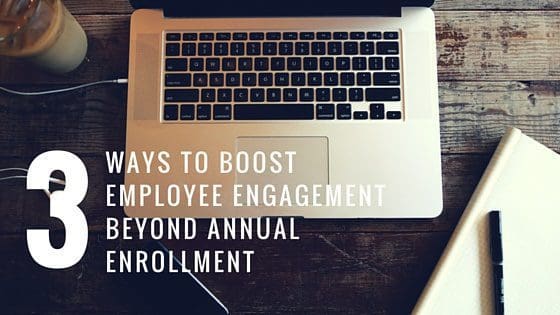3 Ways to Boost Employee Engagement Beyond Annual Enrollment

In an ideal world, employees would be fully engaged in every step of their benefits decision, but reality tells a different story.
Employees often don’t fully understand their options and wait until enrollment is happening to ask questions. The end result is frustrated employees who feel unsure about their benefits selection, and concerned benefits administrators who wonder what could have been done differently.
As a human resources professional, I understand the challenge all too well. Through my years of experience, I’ve gained a strong understanding of what works and what doesn’t. Consistently, I’ve seen the most success when employees are effectively engaged year-round, not just during annual enrollment. How best to engage employees varies among organizations, but there are a few universal guidelines to consider:
Empower employees through education
Without question, education is the surest way to remedy employees’ confusion about benefits and keep them engaged beyond annual enrollment. Education should not only focus on employees’ options, but also how benefits impact their daily lives and support their life goals.
Simplify the learning process by considering an ongoing curriculum that’s delivered throughout the year. This approach will help employees more effectively understand and digest information. Many employees only consider their benefits at annual enrollment or when they’re facing a life event. By educating employees on how their benefits are applied throughout the year, you’ll likely find that they feel more empowered to confidently make decisions about benefits.
Create a communications ecosystem that caters to the multi-generational workforce
Many companies have millennial fever and for good reason. In 2015, millennials became the largest represented generational group in the American workforce, according to the U.S. Census Bureau. However, for most companies, it’s important to keep in mind that employees span generations and have varying communications preferences. For example, Baby Boomers typically prefer communicating face-to-face or via the phone, whereas millennials tend to like text-based communication, such as email or instant message.
As a benefits administrator, it’s critical to identify how to share benefits information in a way that makes sense for every employee. In many cases, this means using multiple channels to communicate. For example, you may find greater success if you share information by email as well as during in-person lunch and learns. While it does require extra legwork, the advantages of having a well-informed workforce trump the effort.
Start by surveying employees on how they prefer to receive information and what compels them to engage with content. Keep in mind that each employee is in a different place in their life, so consider also surveying employees on the type of information they want to receive. For example, Baby Boomers might be most interested to learn about life insurance and retirement planning, whereas millennials might be eager to hear about the company’s maternity/paternity policy and repayment assistance programs. Based on their feedback, you can build a dynamic, targeted communications ecosystem that meets the needs of everyone in your organization.
Encourage and acknowledge feedback
While effectively communicating to employees is critical, it’s equally important to encourage them to communicate with you. Employee feedback sheds light on their experience and provides perspective that we as benefits administrators don’t always have. It’s one of the best tools to help identify challenges and create solutions that make sense for your company.
To ensure success, make it easy for employees to deliver feedback – for example, you can host monthly office hours or set-up an online forum where employees can post their comments. If you’re having difficulty collecting feedback, there are a number of tactics you can implement to encourage employee involvement. For example, create an incentive system where every employee who submits feedback is entered into a monthly drawing for prizes, such as gift cards, complimentary lunch or even extra time off. Proactively nudge employees for their feedback by sending a monthly email questionnaire, or presenting polling questions during staff meetings. Most importantly, acknowledge all feedback you do receive. If employees know they’re being listened to, they’re more likely to continue sharing their thoughts.
Check our resources page to learn more about employee engagement, and check back for more insights on benefits administration done right.
